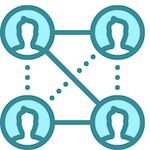“Is coach home?”
I am ten years old and just opened the front door. It is pouring rain and a huge man is standing on the front porch, bent over and sopping wet.
He asks again, “Is coach home?”
I run back to the kitchen table where we are eating dinner and tell Dad that some man is standing on our front porch. Dad goes to the door.
While Dad takes him into the living room, Mom puts the coffee pot on and I hear muffled voices and an occasional light crying from someone who must truly be in a lot of pain.
Sometime later, Dad walks out with him, he is standing straighter, they shake hands and he disappears into the dark night.
At breakfast the next morning, I ask Dad who stopped by last night and what was going on.
Dad said that was so and so, and he stopped by last night to talk.
“That was so and so”, I said excitedly. “He played football for you, he was first team all-conference, got all state honors when he played for you. He did not look so good last night”, I finished.
Dad turned to me and said, “Sometimes, life gives us a bit more than we can handle. People deal with this in different ways, some run away from it, some drown it in drink, some take it out on others and some people have the courage to simply say, “This is too much for me right now and ask for help. There is nothing wrong with asking for help; we all need help from time to time and people that recognize that they are in trouble and ask for help usually get themselves turned around pretty quickly”.
It took me years before I understood what my Dad meant. Strength comes with the ability to share weakness.
Leaders that are unable or unwilling to express their vulnerability, especially within their leadership team, struggle to master the massive challenges that they face. As a leader, if you are really striving to play at your best, at some point you are going to struggle.
Yet if you hold the internal belief that asking for help is a weakness, you will not reach out and get the help you need to move through whatever challenge you are facing. When leaders confuse vulnerability with incompetence or helplessness, they overcompensate and hide or disguise their vulnerability. By attempting to appear strong, you actually become weaker.
As a leader, the cost of not expressing vulnerability compounds itself because those around you mirror what you do and what you say. When you are not asking for help, people that report to you will not either. When people feel that they have to manage everything on their own, or risk being seen as weak or helpless, everyone struggles.
Leaders who express vulnerability as a positive and necessary leadership characteristic invite openness, sensitivity and demonstrate self-confidence within their team; this can be a real game changer. It reminds us, and those around us, that we are authentic, and above all human. When you know, and can publicly share, what you do not know or you cannot do, you can learn it.
I will be forever grateful to the man (and the many others), who showed up from time to time on our front porch. They were able to express their vulnerability, coming forward when they thought they could not bear no more burden. They gave me a valuable insight that I still profit from today.
In this issue of news2use, I will share the implications of personal, team and organizational vulnerability and how you can use this to grow yourself and your business.
Regards,
Dan
“Relevant & pragmatic ideas, tools and insights to play at your best.”

For You
There is a lot of talk about disruption. Disruptive technology, disruptive strategy and disruptive innovation are hot topics.
We must not forget that disruption is first and foremost, a personal experience, meaning we have to disrupt ourselves (or be disrupted) before we can crusade for any other type of disruption.
If I am not comfortable with being vulnerable, I am going to have difficulty disrupting myself or creating opportunities and wins when disruptions occurs.
Here are five ways to strengthen your disruptive competence:
- Seek “first time” experiences. When was the last time you did something for the first time?
- Embrace constraints. Stop complaining because you do not have the budget you need or the right number of head count. Remember that disruption (and innovation) are driven out of constraint.
- Personal disruption is a creative process, and we are most creative when we are positive. Make sure your attitude is at the right altitude.
- Examine and break personal assumptions. Assumptions can hold us tightly in the status quo orbit. It is sometimes amazing to see how people operate because of what they “think to be true”, without really testing (or breaking) their assumptions.
- Let go of the need to be right, embrace your vulnerability, so that you can more readily ask others for help and learn from failures along your disruptive journey.

For You & Your Team
Strategy reviews.
Most leadership teams review their strategic progress, comparing what they aspire to do with what is actually happening.
What is happening or not happening in your strategy review sessions?
Do you experience strong expressions of vulnerability, or not, in your strategy reviews?
Some do, most do not.
Not all, but many strategy reviews are really a masquerade party, where leaders put on their professional mask and try to show that things are going well, when often they are not.
People do not ask tough questions, thinking,” If I dig into his business critically, he might do the same to me,” and people begin to practice friendly avoidance of the key obstacles to success.
Few leaders stand up and say, “I am uncertain how to engage my team on this new initiative, can anyone help me?”
Simply because a strategy review is full of slides and content, does not make it rich in vulnerability, yet the latter is where we can help others, learn and improve.
If everyone was as good as they say they are during strategic reviews; why do so few organizations meet or exceed their strategic objectives?

For You, Your Team & Your Business
Where and when do you encourage organizational vulnerability?
Naturally, you do not leave your company doors unlocked all night long, allow sloppy procedures in your clean rooms, or put your company at risk with half-hearted due diligence activities.
These are not good places to be vulnerable as an organization.
Organizational vulnerability means trust runs deep through your organization. You can measure this by the degree that people are encouraged to take risks and make choices of their own accord.
How does your organization show it trusts the people that work there?
Does your organization express its vulnerability, meaning it trusts people to make choices about:
- Business travel arrangements?
- Hiring people?
- Investing in growth areas?
- Attending relevant activities and events outside the company?
In some organizations, the official word is, we trust you, but through their actions, they say, we do not really trust you and in fact, if you want something, you have to go up three levels in the organization to get approval because the reality is; trust is reserved for a very select few here.
Over time, a company that does not express some vulnerability towards the people that work there will destroy itself, or at best become insignificant because real performers will not want to play ball with them.
It is hard to become a chess player if you feel like a chess piece.
If you take risk taking out of leadership, you create a culture of clones. Clones never develop a sense of ownership; instead feel an obligation to merely execute. This feeling of obligation does not lead to discretionary effort, the secret sauce created in ownership cultures.
Just because you lock up your business at night does not mean that you cannot keep open the doors that lead to a culture of ownership; it starts with exploring how you practice organizational vulnerability.
People, Places & Technology
Putting the power of disruptive innovation to work is the subject of Whitney Johnson’s new book, Disrupt Yourself. Whitney shares how people continue to reinvent themselves through the practices of personal disruption. It is a well written “user’s guide” to personal and positive disruption and I can strongly recommend this book.
Thought for the Day
“What makes you vulnerable makes you beautiful.”
-Brené Brown
